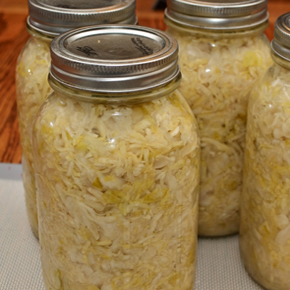Because you need to get a little lacto-fermented acid each day!
What are lacto-fermented vegetables? Keep reading!
Back before modern canning and refrigeration, lacto-fermented vegetables were a common staple in traditional diets. The enzymes created during the process keep the vegetables alive all winter long. Lacto-fermented veggies help you digest other foods, add enzymes to your gut, are anti-carcinogenic, and full of vitamins and probiotics.
If you add just one tablespoon of a fermented vegetable to most meals (or at least one a day), those enzymes will boost your digestive function and increase your vitamin and probiotic intake.
Acquiring Fermented Vegetables:
Best approach: make your own lacto-fermented vegetables using sea salt or a combination of sea salt and whey.
Next best approach: buy real, lacto-fermented vegetables, such as sauerkraut, or its Korean cousin, kimchee, or the Spanish version, called cortido. Find these nutrient-packed veggies in the refrigerated section of your natural foods market, not on the shelf. As with real, lacto-fermented pickles, these vegetables must be refrigerated once the fermenting process is complete. Otherwise, they would need additional processing that would reduce the nutritious benefits of the enzymes created during lacto-fermentation. In addition to your local natural foods market, you can also purchase fermented vegetables online.
Simple Sauerkraut Recipe:
There couldn’t be anything easier than making your own sauerkraut. Seriously, it’s simple! Chop cabbage, throw some Celtic Sea Salt over it and then massage it until you can squeeze the liquid out of it. Yes, it’s a hands-on operation. Squeezing the cabbage is like wringing liquid out of a sponge. Next, you pack it tightly into a mason jar, cover and leave it on the counter for three to four days. Taste it after day two and keep testing it until it reaches peak flavor, according to your preference. Then, put it in the fridge. There are many variations to this basic recipe, but you get the gist of how easy it is to make your own lacto-fermented saukraut.
Serving Suggestions:
Fried eggs and kimchee are a yummy way to start the day. Mix-in sauerkraut with salad greens, vegetable stir-fry or as a condiment for proteins, like wheat meat, chicken or pork.
Adding a dollop of lacto-fermented veggies to your meals is an easy way to enhance nutrition and improve digestion.
Additional Resources:
Wild Fermentation by Sandor Katz
Real Food Fermentation by Alex Lewin
If you are just learning about fermentation, I highly recommend my friend Alex Lewin’s new book called Real Food Fermentation. It has lots of colorful pictures and step-by-step instructions. There are also lots of instructional blogs and videos online. Here is one of my favorites, as it appeals to my lazy side! No knead sauerkraut from one of the Real Food Media bloggers Holistic Squid.

